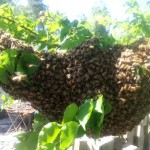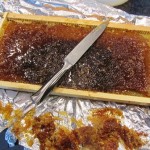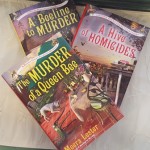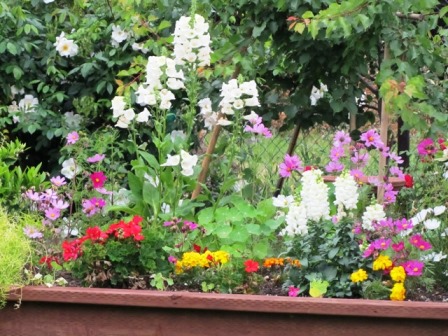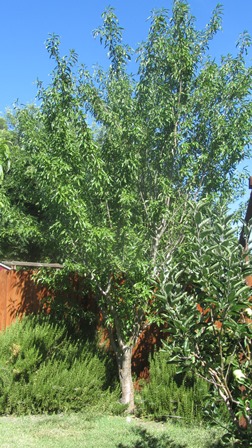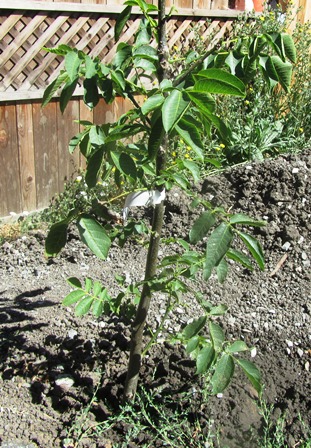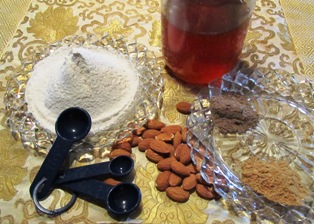Keeping Bees Feeds the Family
The sight of bees collecting pollen makes me happy. Always has. Honeybees are vital to the production of the foods we love such as almonds, apples, citrus, melons, and a large variety of vegetables. My vegetable garden and fruit trees are incredibly productive because of my backyard bees. I guess you could say they feed my family through pollination.
Bees are pollinators. Without them there’s a good chance we’d suffer food scarcity on our planet. Three out of four crops around the globe that are foods that we humans eat are dependent in large part on pollinators. Honeybees also produce honey, nature’s most delicious sweetener, in my opinion.
I keep hives of honeybees on my farmette. It’s not a commercial operation but a backyard hobby that supplies honey for my family and friends as well as pollinating a huge variety of vegetables, fruits, and berries that I grow. Caring for the bees is relatively easy. Harvesting honey, on the other hand, is a bit of work but work I am happy to do.
The first step in harvesting honey is to open the hives. The use of a smoker helps calm the bees. Working quickly is a good idea. We never remove all frames of honey from the hive, but rather leave frames with baby bees and some frames with honey so the bees have food, too.
New frames (some are previously used frames that have the wax structure intact) are inserted to replace the removed frames of honey. A super with 10 frames of honey is carried into my kitchen. Inevitably, I have to capture and release a half dozen live bees that ride in on the frames.
Each frame then gets a hot knife slipped just under the layer of wax. With the wax removed from both sides of the frame, only honey is left. This must be spun out or drained off.
I put four frames of honey at a time into the spinning machine in my kitchen. Beneath the machine’s spigot is freshly washed honey bucket, draped with a new cloth strainer that I’ve taped in place over the top of the bucket. It will catch any pieces of wax or other debris.
When the bucket is full, the strained honey is poured into jars to use, store, or give away as gifts. I put a tight-fitting lid on the bucket and keep the bucket within easy reach on the kitchen countertop.
We eat honey year round. I especially love it in the winter because it reminds me of the honey-flow in spring when the farmette smells like honey and my kitchen is saturated with the scent after pulling some frames from the hive.
Also, the vegetables and fruits that I harvest throughout the growing season are either immediately consumed or preserved through hot-water canning, dehydration, flash freezing. I thank Mother Nature for the blessing of bees that pollinate our foods and give us delicious honey from their hive–up to six gallons for ten frames from a full-depth box!
*NOTE: Learn more about honey bees at: https://www.nationalgeographic.com/animals/invertebrates/h/honeybee/
Also, check out: https://honeybeenet.gsfc.nasa.gov/Honeybees.htm
___________________________________________________________
Enjoy reading about country living? Check out my Henny Penny Farmette series of cozy mysteries that also include lists of farm chores, delicious recipes, farm sayings, and tips for healthy living. Or, take a look at my health, wellness, and spirituality books. All are available online and everywhere books are sold.

More than 150 rituals for sound mind, strong body, and meaningful connections to the people around you
How to Attract Local Pollinators
Today, I spotted a gorgeous bee, big and black with reddish-brown wings, dipping its proboscis into the lavender wisteria and other blooms in my garden. I was stung by a bee yesterday, but that doesn’t stop me from smiling with delight observing this little pollinator at work in my garden.
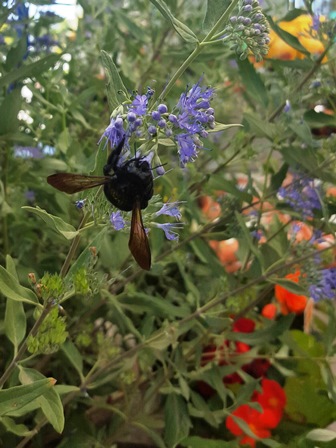
This longhorn bee, twice the size of a honeybee, dips its proboscis (meaning, tongue, nozzle, or snoot) into a bloom.
I admit I’m a fan of pollinators and enjoy watching them work amid the sunflowers, zinnias, cosmos, wisteria, and other blooms in the bee and butterfly garden I planted earlier this year.
The flowers attract hummingbirds, butterflies, bumblebees, and other types of bees, including my own Italian honeybees, the stock of bees most favored in this country (Apis mellifera ligustica). See, http://beesource.com/resources/usda/the-different-types-of-honey-bees/
Honeybees pollinate 90 percent of North America’s commercially produced crops, including almonds. That’s why many Northern California almond growers rent honeybees for use in their orchards during springtime bloom.
The National Academy of Sciences has noted that pollinators are needed to reproduce 75 percent of the Earth’s flowering plants. But there’s been a drop in natural pollinators, in part due to habitat loss and pesticide use.
Populations of the yellow, black, and brown Western bumblebee, once common from southern British Columbia to central California, have now all but disappeared. To attract bumblebees, plant giant hyssop, milk weed, and nettle-leaf horse mint. See, http://www.wildflower.org/collections/collection.php?collection=xerces_bumble
Here’s what else we gardeners and farmers can do to attract local pollinators.
1. Avoid using pesticides.
2. Plant bee, bird, and butterfly friendly native plants.
3. Choose plants that flower in varying diverse colors and shapes to attract a wide variety of pollinators.
* * *
If you enjoy reading about farmette topics (including gardening, beekeeping, and delicious recipes), check out my cozy mysteries A BEELINE TO MURDER and also THE MURDER OF A QUEEN BEE in the Henny Penny Farmette series (from Kensington Publishing).
These novels are available through online retailers such as Amazon, Barnes & Noble, Kobo Books, and Walmart as well as from traditional bookstores everywhere.
See, http://tinyurl.com/hxy3s8q
Now available in mass market paperback, this debut novel launched the Henny Penny Farmette series of mysteries and sold out its first press run.
See, http://tinyurl.com/h4kou4g
The second cozy mystery in the Henny Penny Farmette series, available Sept. 27, 2016
Home-cooked Meals Made Easy for Harried Holiday Shoppers
Family and friends may love the hustle and bustle of holiday activities but often are too tired at the end of the day to cook. There’s a simple solution. Before leaving the house, someone needs to assemble a stew or meal that simmers all day in a slow cooker.
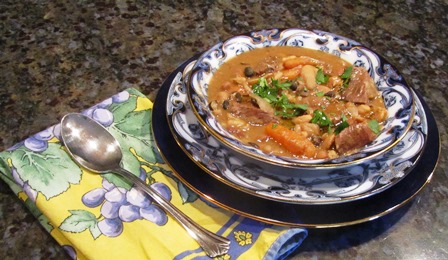
A hearty bean and beef stew is garnished with a dash of extra virgin olive oil, Italian parsley, and coarsely ground black pepper
The process is simple. Choose your meal, put the ingredients in a slow cooker, turn it on, and forget about it until you are ready to feed your gang at the end of the day.
Slow cookers are terrific tools for making tasty stews like apple chicken, Mexican pork and hominy, and red beans with Cajun sausages. Or, make a corned beef and cabbage dish with carrots and potatoes. Beef stroganoff, pepper steak, and even clam chowder or a fish stew taste sublime when cooked slowly for several hours.
Serve your hot meal alongside a simple salad. Choose perhaps broccoli slaw with chopped apples and pears, segments of seedless tangerines, and a handful of sliced almonds. Drizzle or spritz with Asian Sesame Ginger dressing. Put out slices of French bread and possibly a platter of cheese.
Right before serving the meal, sprinkle the hot food with some fresh herbs, a dash of olive oil, some shaved cheese, or coarsely ground black pepper. What could be easier?
For more delicious farmhouse recipes, tips for keeping honeybees and chickens, growing heirloom vegetables, and tending fruit trees, check out my latest book, A BEELINE TO MURDER.
Released in hardcover, the book makes a great gift for holidays, birthdays, and other celebratory events. Available online and a brick-and-mortar bookstores everywhere. See, http://tinyurl.com/p8d6owd

The first cozy mystery in the Henny Penny Farmette mystery series by Meera Lester, from Kensington Books
Northern California Nut Trees in a Nutshell
Take a trip into Northern California’s great Central Valley and you’ll notice how the landscape becomes dotted with nut tree farms along with vegetable fields, fruit tree orchards, and dairy farms. While Texas dominates the pecan tree market, California’s big three nut crops are almonds, walnuts, and pistachios. With nut prices on the increase, backyard gardeners might consider planting a tree or two if they have the space.
Some nut trees, such as almonds, require pollination assistance–a couple of different cultivars and honeybees will do the trick. For this reason, commercial almond growers pay beekeepers to bring their hives in to pollinate California’s early almond crop each year. Growing almonds is big business in California (it’s the third leading agricultural product in the state); the decline in honeybee populations is bound to affect this profitable crop.
The Central Valley has the perfect climate and growing conditions for almonds. It’s estimated that there are roughly 5,500 almond growers in the state. Many are commercial growers who capitalize on the rich, well-drained soil, and the hot summers and cool winters of Northern California. But California’s continuing drought is causing concern to almond growers since almonds require a lot of water. Backyard gardeners, too, must consider the water requirement of almonds before planting trees.
A newly formed almond on the tree looks like an unripe fuzzy peach because almonds are related to the peaches. Mature almond trees reach 20 to 30 feet tall. Some popular cultivars in zones 5 through 8 are Hall’s Hardy, Nonpareil, Peerless, and Mission. My neighbors have gorgeous, healthy almonds growing on their farmette.
The California Black Walnut and Persian Walnut (with cultivars of Franquette, Chandler, and Hartley) are valued for their stateliness, shade, bountiful crops, and longevity. Walnuts contain healthy nutrients. Cultivars of the English walnut are fast-growing and the nuts are thin-skinned and bountiful.
If a walnut is planted at the birth of an individual, and he lives 75 years, that walnut tree might could still be growing when the person breathes his last breath. The black walnut can reach 100 feet in height. The nuts have an thick outer hull that can blacken sidewalks and driveways with their stain; also, the tree also can be toxic to other plants.
In comparison to walnuts, filberts/hazelnuts are considered small trees (achieving heights of only 10 to 40 feet), they are often the nut tree of choice for backyard landscapes. DuChilly and Daviana are excellent pollinizers with Barcelona. Other cultivars are Bixby, Royal, and Hall’s Giant.
Pecan trees grow much larger than filberts, often towering 70 to 150 feet. Some cultivars include Major, Peruque, Stuart, and Colby. The cultivars of Wichita, Western Schley, and Cherokee are excellent pollinators for each other. Of all the nuts valued for their antioxidants, pecans rank the highest.
There is a pistachio tree growing a mile or so from my farmette. While pistachios love the Mediterranean climate of the Central Valley, in some places the trees perform better than in others. The nuts are highly valued by consumers. Growers have taken notice. Pioneer Gold, a varietal that’s been around since 1976, remains a popular choice. The trees are wind pollinated and require a male and female tree for a crop set.
If you have room in a backyard garden or on a farmette or field, consider planting one or more nut trees. You’ll be rewarded with shade and heart-healthy, nutritional snacks for years to come.
Old World Honey Cake
Honey cake has been called the world’s “oldest-known cake.” Versions of the cake date to biblical times, although food historians will tell you that it wasn’t really called cake back then. The English term “cake” dates to the thirteenth century and derives from the old Norse word, “kaka.”
Modern pastry chefs have the ancient Egyptians to thank for pioneering the culinary process of baking. The ancients’ version of honey cake was most likely an old-world type of flat bread drizzled or lashed with honey, the sweetener of choice during ancient times. In fact, bread and cake (even today) are not too different. Think of pumpkin bread or banana nut bread. A slice of either at breakfast is like having dessert in the morning.
The Romans added eggs and butter to get a lighter dough. Cooks began to add nuts and dried fruits such as dates, figs, and raisins to make their honey “cake” even more mouth-watering and special.
Although that round shape that we associate with cake today didn’t emerge until the seventeenth century, medieval bakers in Europe had for centuries continued to create new versions of the honey cake with spices such as ginger. In fact, the taste for ginger resulted in gingerbread. The addition of dried fruits, nuts, spices, and (later) rum and brandy yielded the cake we know today as fruitcake.
The following recipe is more of a medieval style honey cake, although during the medieval period cakes tended to be smaller than we think of them today.
Old World Honey Cake
Ingredients:
1 cup plus 1 tablespoon honey (preferrably dark)
1 teaspoon cinnamon
1/2 teaspoon ground nutmeg
1/2 teaspoon cardamom
2 teaspoon baking soda
1/2 cup softened unsalted butter
1 cup dark brown sugar
4 eggs (separate yolks from whites)
1/2 cup unflavored Greek yogurt
1/2 cup cottage cheese
1 tablespoon fresh orange zest
2 1/2 cups flour
1/2 teaspoon salt
1/2 cup raisins
10 dates, stoned and chopped
1 cup walnuts, finely chopped
Directions:
Preheat the ove to 300 degrees Fahrenheit. Grease a ten-inch tube pan.
Combine honey, cinnamon, nutmeg, and cardamom in a saucepan over medium high heat and bring to a boil, stirring often. Add baking soda, stir in, and remove from heat and let cool.
In a mixing bowl, cream butter with brown sugar. Beat in one egg yolk at a time. Add this to the honey/spice mixture.
In a bowl, mix yogurt, cottage cheese, and orange zest.
Sift half the flour and the salt into the honey/spice mixture (that now also contains the creamed butter, sugar, and eggs). Combine remaining flour with raisins, dates, and walnuts. Mix this into the bowl of batter.
Pour the batter into the greased tube pan and bake for 1 1/2 hours. Test for doneness by inserting a toothpick into the cake. The toothpick, when pulled out, should have no batter on it.
Cool the cake for 15 minutes before inverting. Brush with 1 Tablespoon of honey.
Optional: Sprinkle with slivered almonds. After the cake is completely cooled, store in an airtight container for 24 to 48 hours before serving.
Copyright Meera Lester 11-28-2012
 Facebook
Facebook Goodreads
Goodreads LinkedIn
LinkedIn Meera Lester
Meera Lester Twitter
Twitter






